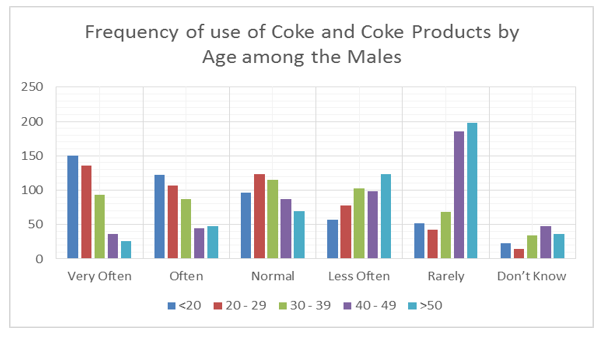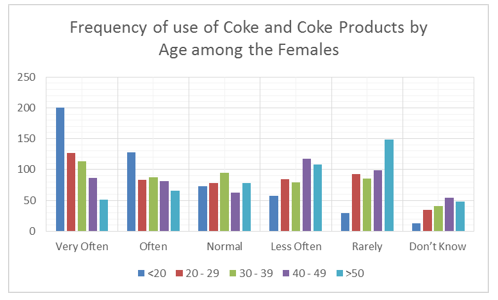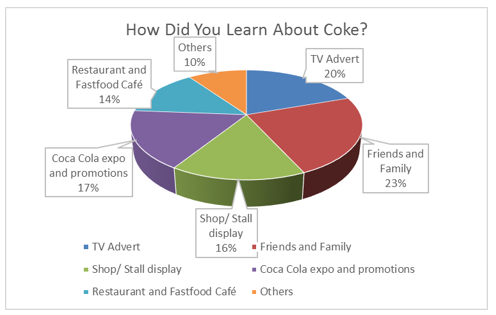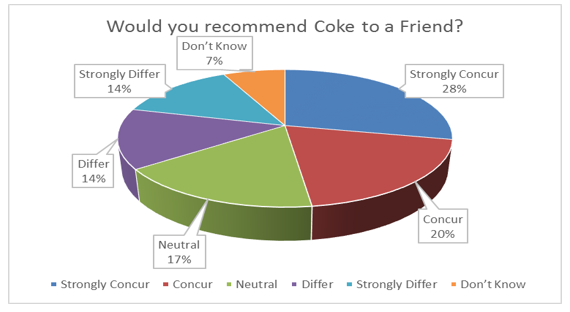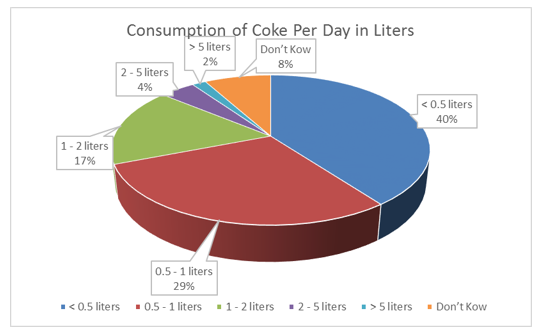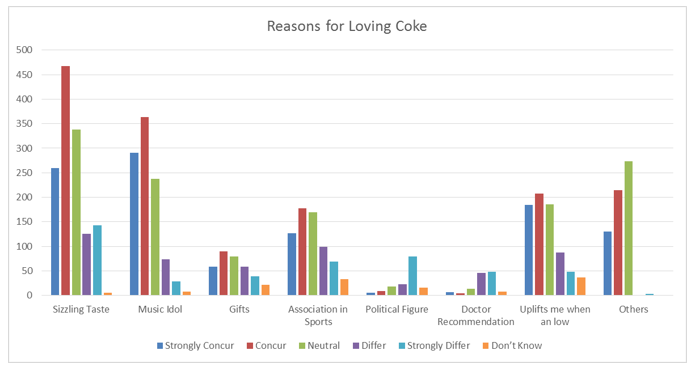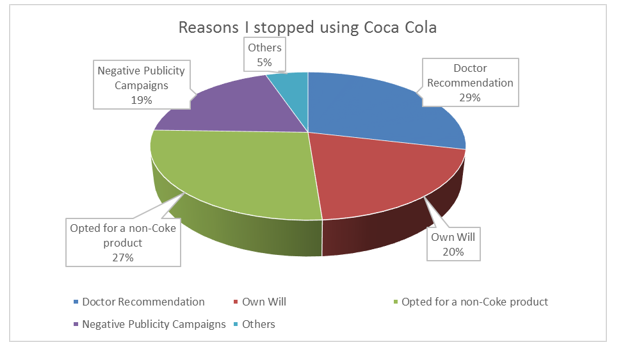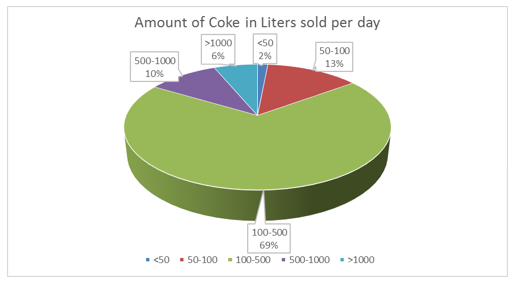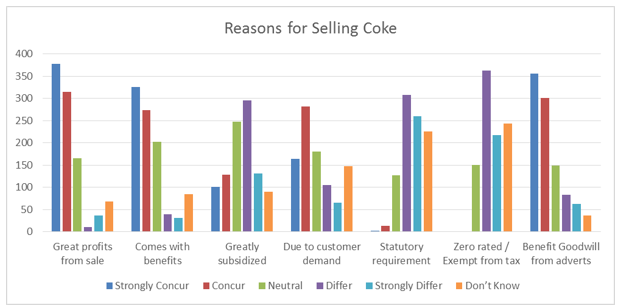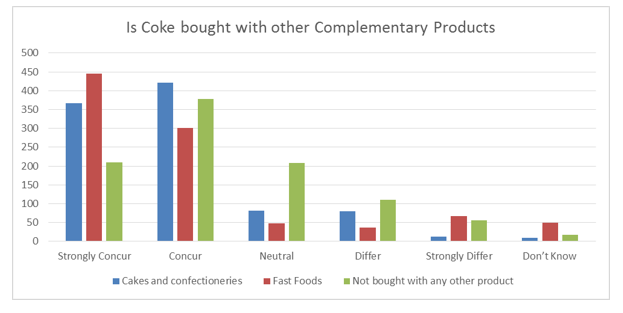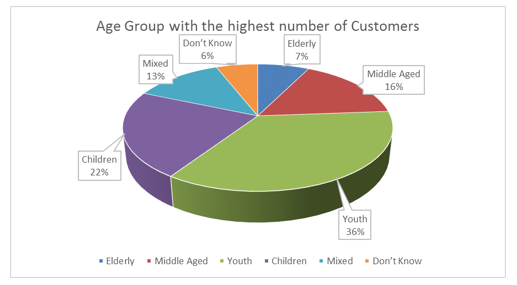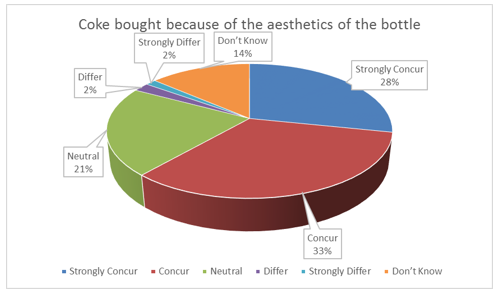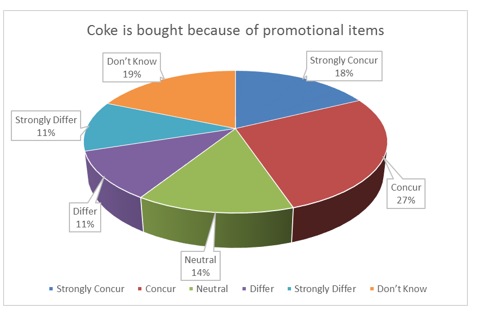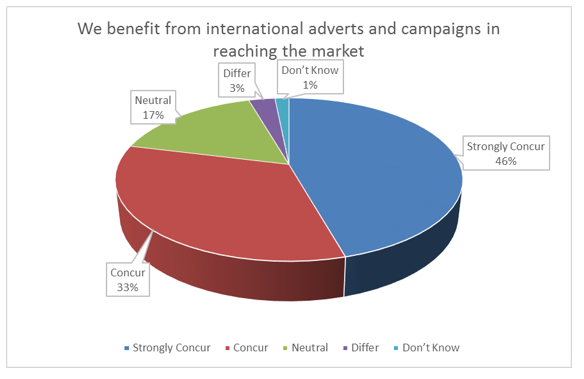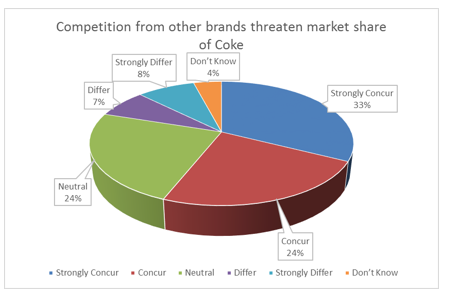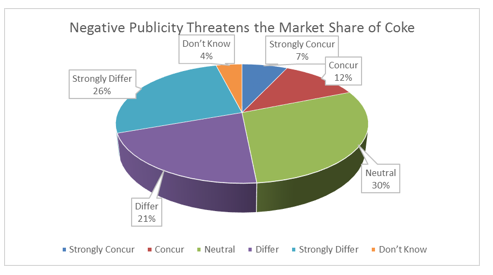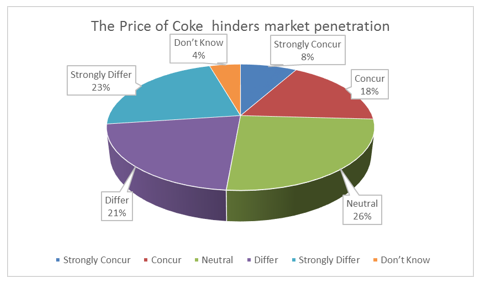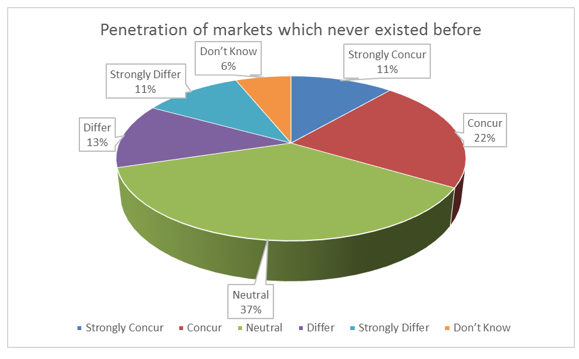Executive Summary
Coca Cola has been one of the most successful companies in selling soft drinks throughout the world. The success of the company in selling the beverage drink comes from the fact that it has excellent strategies laid down to exploit both existing and new markets. The strategies have seen excellent marketing and advertising campaigns that have seen the success of its products worldwide.
This research paper aims at studying the market penetration of the Coke brand worldwide. The marketing strategies that have made it a home brand for the many people who love it. The paper also looks at its diversification in different products that have made the company still maintain a leading edge over it competitors throughout the world. Because introduction of the new products into the existing market only diversifies the preferences of the customers and also capture new customers in the existing market.
The market penetration statistics are going to be analyzed in SPSS software which is Statistical Package for Social Sciences. It will be used for the analysis of the data from the questionnaires which will be issued to get information from the respondents. The questionnaires will help prove the hypotheses developed and prove on the market penetration of the brand.
CHAPTER 1: INTRODUCTION
Brief History of Coca-Cola penetration and Marketing strategy
Coke, a product of the Coca Cola Company, Dr. John S. Pemberton established it in 1886 when he created a unique taste soft beverage for sale at beverage joints in Atlanta. The flavored syrup was added to carbonated water and credited “outstanding” when samples were tasted of it. Frank M Robinson later called the drink Coca-Cola and came up with the trademark as it is to this day (Pendergrast, 1993).
Shortly after creating the formula for the syrup, Dr. Pemberton died after selling part of his business to different people. Asa G. Candler bought most of the stakes and continued the business after Pemberton’s death which saw the distribution of the beverage go beyond Atlanta. In the year 1894, Biedenharn Joseph put up the first bottling factory inside his Mississippi soda fountain since the demand was growing exponentially and there was desire to make the beverage portable to other parts and states. Large scale bottling for the brand became a reality in 1899 when John Lupton, Joseph Whitehead and Benjamin Thomas bought the rights to bottle and package from Asa Candler for $1 (Standage, 2005).
The three business individuals from Chattanooga Tennessee established the Coca-Cola worldwide bottling system. At that time, Coca-Cola suffered imitations in bottling from the competitors and decided on a distinctive standard bottle in 1916 that set it apart from the competitors. The bottle was later trademarked in 1977.
The marketing strategies of the company have been different and have evolved over time, the first marketing strategies were through promoting free samples and through coupons of the beverage which was innovative back in the year 1887.
Newspaper advertising followed later and distributing promotional items that did bore the name Coca-Cola to all the participating pharmacies that sold the product. From the years later in 1970s, the use of coke was associated with family, friends, and interestingly good times. During this period, the sale of coke had transformed from the sale as a pharmaceutical product in pharmacies to a beverage in shops and stores. Advertising has been the major way in which coke has penetrated different markets (Standage, 2005).
Personalized advertising has majorly been the best promotional campaign that made the excellent appeal to the consumers of the brand. For instance, the computer animations tested in 1993 in which polar bears, a symbol of mischief, innocence and fun, were used in advertising campaigns made a great impact in promoting the product. The best feature admired in this advert was the ability of having a photo of you taken with the 7’ tall Coca-Cola white Polar Bear.
Other interesting advertising campaigns were the association of Coca-Cola with music stars who even composed songs for the brand and associated its use with refreshment, comfort, fun and status in society. Coca-Cola involvement in games and sports like the soccer World Cup and Olympic athletics has always been used to make it distinct and make it associated with the victors in sports. In 2009, the “Open Coke Open Happiness campaign” saw the product stand out once again in the market as an outstanding brand over the years of its consumption. Coke remains the leading beverage consumed worldwide among the manufactured beverages (Cortés, 2012).
Research Problem
The research problem is the gap that needs to be filled, understood, improved or a solution found to those interested in the subject area. It is often prompted by lack of understanding of the phenomena, or the need to improve the efficiency in the system concerned. In this project, there is a gap in the knowledge in the market penetration of the Coke product and its brands that has prompted its study.
There is need to understand the way coke navigates through the existing market and its approach to new markets amidst competition from other brand and still maintain excellent stakes in the market worldwide.
Source of the Research Problem
Coke has always had its ups and down in the market. The brand has not always had it smooth in its operations. It has always faced large varied nature of challenges ranging from competition, law suits, and even customer doubt on the safety of use of the beverage. All these has always had an impact on the sales of the product and sometimes the management has always resorted to tough campaigns to reclaim the markets with decreasing sales or to reassure the customers of its continued responsibility.
The challenges often faced by the brand has as stated above are lawsuits for example in 1911 when it was sued for using leaves of the coca plan to manufacture the beverage and claiming medicinal benefits when using the product, though it had earlier removed the use of the coca plant in 1903 and replaced it with caffeine and dropped the medicinal claims.
The other problem has been from competitors trying to ape the chemical formula and branding of their products so as to edge out Coca-Cola in their sales. This has had the effect of dividing the market share and reduced that stakes of this beverage in the market. Imitations come even in the mode of packaging and naming of the products so as to confound the customers to opt for the competitive products (Dealtry, 1992).
The consumers of the product sometimes also stop using the product or reduce their consumption. This is often from the side effects they gate from daily dosages of the beverage of from health reviews of the products. Often the stimulating effect of the caffeine in the product has been a problem and caused addiction which some health practitioners have warned their patients. In addition, the potential effects of those with certain medical conditions like gastrointestinal ulcers or the potential of it being carcinogenic are some of the things the brand has to face while it markets its products to the consumers.
Background of the Problem
The challenges faced by the company in selling its products have made it come up with different strategies aimed at increasing its sales and maintaining it market lead. Therefore a research was conducted using both primary and secondary data to check the mode of penetration coke uses to attain its level in the existent and new markets.
The need to understand the strategy employed by Coca Cola Company will be crucial in implementing the marketing strategies of other products that may try to enter and conquer markets in different industries. Therefore understanding how the Coca Cola Company does the business of edging out and surviving competition is necessary for the entrance and conquering of the markets for the new products.
The mix of the marketing strategies is of prime concern to understanding the success of this Coke and its products (DeFranco, 2015). The Ansoff matrix and the BCG matrix has been used to try to explain how it conquers and maintains the lead in the market. Other reasons of checking the success of the product are also analyzed like the SWOT, PESTEL and Porter’s five forces model are used in understanding the way that it has withstood the tough times in the market worldwide.
Other strategies used by the company in its success are also used. For example the different diversified products the company has like Sprite, Fanta, Stoney and other brands sold under this name are also checked on the contribution thy have made to make the company outstanding. In local countries, coke has partnered with restaurants in advertising so that not only coke benefits but also the fast food restaurants benefit for selling their food together with the beverage. All these help coke to edge out the other competitors and reach even those had not preferred to eat such snacks with coke.
Therefore the importance of the project is attached to understanding the success enjoyed by the product from its inception to the present, while looking at how it exploits the existent markets, reclaiming the lost markets and entering new markets. It will be researched in terms of the marketing strategies adopted by the company and also the survival technic in the current markets. From the conclusive evidence obtained then it is possible to ascertain the success and qualify the claims made on the penetration of the product throughout the world today.
Statement of the Research Problem
The need to understand the way perfect marketing strategies and retaining loyalty of customers and markets led to the choice of one of the leading companies in the beverage industry. The company selected has not used new techniques in marketing but has employed the old technic in an innovative way that appeals to the customers through the ages since its existence. The improvised technics have edged out competitors who are new entrants or do not have enough funds to drive their products in such a large and diversified nature of customers.
Coca-Cola’s mix of strategies has intrigued the study and will help in forming a solid conclusion on how companies should use what they have to build a brand name and be able to stand.
Together with understanding the way Coca-Cola has made its success, there are some key aspects of the research that need to be developed and understood. For instance, understanding how to create and administer questionnaires is one of the goals that will help to get firsthand information from the respondents on their views about the brand.
Second understanding how to analyze the data from the questionnaires using the analytical tool preferred. The use of the data analyzing tool in the research will be vital so that the trends and analysis is made much simpler, and easily understood. This software is also excellent in presentation of the data so that credible conclusions can be made from the inference information.
Other second-hand sources of information are also incorporated in the study to assess the effect of their independent surveys on the success of the company in doing business. This will also help get a higher understanding of the ways in which the business has been conducted to ensure success and better incorporated what may have been missed out by this study (Coca-Cola Company, 2015).
Research Purpose
The aim of the study getting a comprehension of the market penetration of the coke brand. To analyze the strategies adopted and their effect in increasing the market share. It also aims at assessing the markets that have not been effectively utilized or they have not gotten to when there is potential of it being an excellent market. The project also aims at understanding the appeal of the coke products to the consumers and allowing them give a reason why they cherish or dislike the brand and its products. It is expected that from the questionnaires, it will be deduced the effect of the marketing strategies adopted by the company to advertise its products in the market.
Research Questions:
In order to fully understand market penetration of the brand, the research needed to answer the questions below. This will help understand the way the product it navigates and makes its success amidst competition and uncertainties of the market. In addition, the questions are meant to open the mind further to more research about the product so that any other person intending to study in this area will have a starting point to direct the research. The following were the things that needed to be understood:
- What kind of markets does Coca-Cola target, does it employ market stratification technics? What is their aim and mission in seeing their products excel in the market? What has been the result or effect of their marketing strategies, have they maintained the existing market positions or have they increased market share? What are some of their Corporate Social Responsibilities that have attracted customers and penetrated markets they did not exploit before?
- Where has the brand sold or not sold? Where does the company make the most sales, its highest exploited market? Where is the company currently targeting to make its sales? Where in the world has the company faced the most difficult times in trying to penetrate and outshine the existing beverage companies in that area when they are a potential market?
- Who are responsible for the success of the company, do the governments, health practitioners or any other group in the countries have a role to play in endorsing the coke products? Who are always engaged in advertising campaigns to make the product successful, who are used to reach markets with high reluctance? Who are responsible for engaging partnerships, mergers and acquisition or creation of new products to edge out competition?
- How does it reach and penetrated the markets? How does it deal with competition from the other various beverage companies? How does it deal with consumer negativity and give an assurance of safety of the products and reclaim the markets once lost? How does it maintain hold of the current market it has? How effective is the pricing strategy to the acquisition of new customers?
- When does it expect competition to start pausing threats and outshine it? When will it launch new products? When is it going to launch campaigns and tactics to capture the markets currently unexploited?
- Why does it not release the secret recipe for its product when it has already gained the market share? Why does it invest so much in advertising when it already has the market share it needs? Why does it partner with other companies in the fast food industry when customers know automatically that what the buy in the fast food restaurants will be best when served with coke?
In answering these questions and concerns I believe it will be possible to understand its penetration into the market. It will also be possible to formulate the hypothesis and the questionnaires to direct the study, so that effective analysis of the data can be used to make inferences in lie with the study.
Significance of the study
This is the relevance or importance of the research to the profession in which it is related to. This researched is aimed at understanding market penetration of coke and how to use a convenient analytical software to analyze the market and form conclusions in line or against the hypothesis formulated. Therefore the research is centered on understanding the concepts of market penetration and maintaining hold of the existent markets.
The findings of this research could be implemented by other businesses to improve their grip in the markets and have an outstanding performance. They can also be used to study on how companies can venture into new markets and have their profits assured. One other thing to learn is the market segmentation strategies, for example Coca-Cola makes different products for different markets so that consumers still use their products under a different brand or under a different taste. For example coke sugar free and the ordinary coke, or products such as Fanta, Sprite, Stoney, Minute Maid or Dasani water.
Scope of the Study
The research aims at understanding market penetration of the brand and not the marketing skills used. Penetration and retention of customers depends highly on marketing and advertising campaigns but it is just one of the methods used to break the ice and reach customers.
The paper may deal interchangeably with the marketing methods used, because it is the marketing methods that help reach the customers. But the center of it all is not marketing, it also deals with other factors that favor the use of coke for example the governments of countries allowing and endorsing coke products, health practitioners of the popular belief of coke by the consumers that will make it still used even without advertising.
The research does not cover a specific geographical location but intends to cover all the areas of the world because coke is a worldwide brand. In some cases it will be generalized but the study will stratify the questionnaires to different markets as it deems fit so that different perspectives can be arrived at comfortably for good inferences.
In addition to the information from the questionnaire interview, data will also be found from secondary sources like the Coca-Cola sites so that the market share and performance is understood from such places. This is because the sub companies and the regional bottling companies have a perfect understanding of the sales information and the challenges faced in places they sell their products. Such secondary data will be essential too in making credible conclusions about the products.
Research Methodology
This gives and explanation as to how the research will be conducted. The methodology gives the technics used in conducting the study in real markets. It then explains how the conclusions are made basing on the data and the research method used. An advantage of having a defined methodology is tracking the progress of the research and working within the limits.
As stated above the research aims at studying how the coke products and associated products manage to venture into new markets and also conquer the existing markets. Therefore questionnaires and subsequent interviews are used for data collection, SPSS software is used for analysis and presentation of the data in graphs, charts and other appropriate presentation technics. Secondary sources of information are also used to get the other perspective so that conclusive evidence is found for the inferences to be made from the study.
It is good to note that since the study is based on the penetration of the penetration of the product worldwide, the research population and samples may be taken worldwide. This means online survey methods may be employed so as to get varied information from different places around the globe.
Finally a report is written to discuss the findings from such data analysis to proof the hypotheses or annul them. Recommendations are also made to help those using the report findings understand the strategies they can employ or what they can adjust in employing their tricks to market their products too.
Conclusion
Coke’s market penetration has not been effectively studied to understand the technic used for it to be a big hit in the market. Its success is mostly attributed to the quality and flavor of the product but there is more to it, the mix of advertising and other market retention and penetration has seen it successful in its campaign to be the world leading beverage. This paper intends to bring out the methods adopted by the company in making sure it maintains the market lead in its major beverage and other products it manufactures. These technics can be employed in various fields by the users of the data and information for their own benefit in line with the study.
Furthermore, this information may be used by the company to make investment decisions of to make and effective appeal to the customers since they will be able to get first hand responses from the customers on how they feel about the product. The company may also see where it is not performing well and go to make a research on how it will access such a potential markets for its own success. It is therefore viable to conduct this research because of the potential of this information to be used by a variety of people or stakeholders.
CHAPTER 2: LITERATURE REVIEW
The literature review explains the analysis of market penetration of the Coke brand using the current mix of strategies employed by the company. It discusses the milestones made so far and the milestones they have not fully exploited in line with the research project. Among the markets they currently operate in, there may be places they are losing grip due to a variety of factors which need to be critically looked into for analysis.
This chapter centers on what they have achieved so far, and what they have lost with time and the challenges they face when trying to enter new markets if they make an effort to. It forms a basis of making analysis of the past success enjoyed by the company compared to the current market trend and the analysis of the information from the research conducted for this project.
In understanding the milestones and the challenges faced by Coca-Cola in marketing the brand and other products associated with the brand, the approach used in literature review is employing five models to help understand what they face in the beverage industry. The models are Ansoff matrix analysis, and SWOT analysis, Potters 5 forces model and PESTEL analysis. These will help capture all the factors that have made Coca-Cola stand out in the beverage industry above all other competing products.
Coca-Cola has made its way into almost every shop and stall in the world. It is sold in over 200 countries in the world, with over 3000 brands of products that are associated with it. It has entered into partnership with many local companies that sell beverages so that they reduce the competition that would be caused by that beverage or sell their products through the same distribution channels enjoyed by the local product. The variety of coke products has always been an advantage to it because from such it is able to enjoy the economies of scale to reap its profits (Coca-Cola Company, 2015).
The most unique feature about Coke is the advertising and marketing campaigns it has used to counter competition from other companies that try to edge it out in the industry. Coca-Cola used almost $ 6.8 billion in marketing expenses in 2015 to realize a total revenue of $ 44.3 billion (Coca-Cola Company, 2015).
The more it invests in the marketing strategies, the more the revenues are expected to rise. The milestones made from marketing are good for the benefit of the coke brand and also the other products produced and supplied together with the coke brand (BOONE, 2012).
When talking about the coke brands it means either of the following Diet Coke, Coca Cola, Coke Lime, Coca-Cola cherry, Vanilla coke, Coke Light, and Coca-Cola Zero.
All these are the different brands of coke. When talking of other brands under the Coca-Cola Company, produced by the company or just by the subsidiaries, it is over the 3000 brands worldwide. The major Coca-Cola associated brands are Fanta with all its brands (Fanta Orange, Black Current, and Fanta Passion), Sprite, Stoney, Minute Maid, Nester A and all other tea, coffee, and beverages produced and distributed under the brand name Coca-Cola (Cortés, 2012).
Understanding Coke Penetration through model analysis
As discussed above the models used to understand and explain the current market share of coke are the Ansoff Matrix, the Potters 5 forces model, SWOT and PESTEL analysis.
THE ANSOFF MATRIX:
The main goal of any entity is to expand or grow and exploit markets whether it is a new firm or an already established business firm. The growth of the firm will depend on the mix of strategies it will employ in trying to be a successful entity in business, either using the existing or new products or using exploiting new or current markets further. Its four main strategies as discussed below to exploit its potential:
Market penetration: It involves attempting to increase market share using the existing product. The company sells more of the product to existent customers or it attempts to reach more of the new customers in the same market. It implies that concentration and focus is on the existing market, channels have to be found to increase consumption of the good to the existing consumers.
On the other hand there are potential consumers who never used the product before in the same market, these also are targeted by the company so that they make more use of the make the currently have. The company has effectively used this through promotional campaigns (Hussey, 2001). The currently held customers are appealed by the promotions while those who never used the product are attracted to use the product in the same market.
Sometimes greater is achieved through friends recommending coke to friends or offering coke with other complementary goods like confectionaries and fast foods. The best way this was achieved was in 2015 when coke used names of individuals on their bottled packages, for example, bottles or packages with the names ‘Vivian’ and ‘Andrew’ respectively, when Vivian buys Andrew coke with his name as a present, Andrew will automatically take more coke if he was a customer or Andrew will be introduced to coke from the personalized inscription of his name on the bottle.
Product Development: this entails creation of a new product to be sold in an existent market. Sometimes the sale of products may involve rethinking of ways to create a lead out of what is already known in the market. For instance an existing market may have been used to the product such that their marginal propensity to consume it decreases. When such a point is reached, the company has to strategized and create a new product that will arouse the desire to consume the product again (Moussetis, 2011).
One such product introduced by coke was the cherry coke introduced in 1985. Up to 1985, the market had been used to Coke, but the introduction of Cherry coke with the flavor of cherries opened the existing market further to greater potential. And since that time, there have been several Coke flavors developed to the market for example vanilla coke, lime and lemon all sold under the brand name Coke.
Market Development strategy: this strategy tries to exploit a new market using an existing product in that. This mostly occurs when a certain of its products would have caused market segmentation from its nature, or trying to reach a geographical location never exploited before.
It takes a keen eye of the organization to sell an existing product to a new market especially when there was market segmentation from the previous sales (Yin, 2016). Market segmentation may have occurred due to age, gender, and preferences etc. that segregate the potential consumers of a product. For instance, Diet coke was introduced in the 1980s and was preferred by women for its low sugar ad low calories, but men shied away from it because it was considered feministic. It took over 30 years to 2005 for Coke to realize and develop Coca-Cola zero, which had no sugar and zero calories for men to embrace the product considering it masculine.
Market Diversification: This is a penetration strategy aimed at reaching new markets with new product for such a market. Market diversification may take two forms. These are related and unrelated diversification. Related diversification entails reaching a new market with a new product which is related to the major product sold by the company (Yin, 2016).
Such an example was when Coca-Cola acquired Glaceau in 2007 so that it starts selling health drinks after the sale of carbonated beverages declined due to health awareness of the customers. Sometimes the way to reach new markets is using new unrelated products for promotions and sensitization. Example of these items Coca-Cola has used are T-shirts, caps, pens, fridges and other merchandise. Those gifted with such promotional items will either stock coke in their houses and shops or will frequently use coke form the gifts they have received.
COCA-COLA AND PORTER’S MODEL:
The model helps develop the business strategy and a framework for the industry analysis. It draws inferences to both the internal and external threats that threaten the existence of the company and therefore the strategies used to cement the market lead are realized and employed for success.
The model tries to explain the challenges in the industry and how to cope with them to ensure sustainability: It also explains why existing brands will maintain their market share or even penetrate more while the new brands may fail.
Threat of new entrants: Advertising forms part and parcel of the soft drink industry. The well established firms have an easy time advertising due to availability of funds and the large market share. It makes it almost impossible new brands to come and try acquiring the customers, since they will struggle to expand their visibility (MBALECTURES, 2010). Coke always excels above competitors because of adverts and its marketing campaigns. Customer loyalty also makes it difficult for new entrants into the market.
The existing brands always have established systems to capture and retain customers even through personalized marketing and selling, therefore new brands may not take away the market share they have. And for this reason coke maintains its loyal customers and also reaches out more to those they had not accessed before.
Competitor’s threat: threat of competition is always present in the industry from the existing companies. In the beverage industry the main competitor against coke is Pepsi. These do not compete in terms of pricing but in product differentiation (Valuationacademy.com, 2014). They produced varied brands aimed at reaching different market segments, but Coca-Cola has always maintained the leading edge over Pepsi.
These two companies dominate the beverage industry presently and there is no expected threat in the near future because the likely threats were hit by the recession in 2008, therefore coke has always tried to outshine Pepsi knowing the competition is less likely to come from another source.
Substitute threat: The threat of substitutes in the industry can always pause a challenge to the existing brands. In the beverage industry there are a wide range of non-alcoholic substitutes ranging from coffee, tea and other health drinks.
Although these may not have enough advertising campaigns and funds to outshine the big brands like coke, the consumer incurs no cost switching to their use, therefore it is almost impossible to hold the consumer from using these substitutes. In addition, the price of the substitutes always have almost the same price or even lower than Coke, the consumers will often switch to use of substitutes making coke lose market where it had penetrated and had a good share.
Supplier bargaining power: the bargaining power of suppliers may affect the strategies and market penetration of the companies. Coke’s raw materials are simple products available for almost every supplier therefore the threat of suppliers does not have any effect on them, that’s why they maintain a good market share without fear of source of raw materials, and if a supplier is reluctant the company can always shift to the next without incurring a lot of costs. I
n case of threat of forward integration, the suppliers will fail because Coke has established a good network of the manufacturing industry, the bottling and the suppliers to the consumers (Valuationacademy.com, 2014). Any supplier of raw materials will need to establish his own system which will be too costly and thus coke has remained the link between all these and maintained the market or even penetrate more.
COKE’S SWOT ANALYSIS
Coca-Cola promises good returns in future despite the fact that it has challenges it faces. It has calculated measures to use its strength and opportunities while try to conquer the threats and handle weaknesses with simplicity.
The strengths of the company are the goodwill enjoyed from brand awareness and good distribution network. Coca-Cola is identified with its logo and the colors that are distinct. These brand name sets it forward far above the existing brands in the market. Furthermore, the vast resources employed by the company in marketing and advertising only make it greater and more appealing to the consumer more than any other brand (Sawant, 2010).
The use of music and sport idols in advertising attracts attention from those who love such artists and sports men. In addition to that, the vast distribution network enjoyed in over 200 countries worldwide make it exceptionally strong in penetrating the markets and maintaining their hold on that which they have acquired.
The weaknesses of coke emanate from the foreign currency fluctuations and from the mismanagement of water. When trading and selling the products in foreign countries, there is always the risk they face due to the fluctuation of foreign currencies and also from the tax rates. Such fluctuation of foreign currencies may make the company incur loses. The fluctuating currencies also affect the other balance sheet items, cash flow items and income statement items.
Sometimes devaluation o currencies in developing countries also adversely affect the trading position of the company when selling the products (Vaněk, Mikoláš and Žváková, 2012). Coke therefore has a hard time penetrating such markets due to cost implications. Water management has been an issue, the bottling and manufacturing companies use a lot of water which could be used efficiently especially in countries with scarcity of water. It becomes difficult to operate in such countries where water is restricted and consequently the products will not penetrate deeper due to water rationing in such places.
The opportunities available for Coca-Cola are diversification and extended reach. Diversification deals with the coke brand dealing in different products of its on and also engaging in different products to be sold under their brand. For example Coca-Cola has reached wider markets by buying stakes in different companies and using their distribution lines to reach other markets.
For example the purchase of stakes in Monster beverage, Thumbs up all these has helped the brand advertise not only their products but also the products of their subsidiaries therefore they enlarger their penetration/ reach further (Jurevicius, 2013). The company also opted for extended reach through other health products. Coke beverages have had negative publicity because of the sugars for those with health problems, but the company has evolved to sell water and other health drinks that reach new markets while providing additional entry into the healthcare market.
The threats of the brand mainly come from nutritious drinks from competitors and public sensitization of the effect of the beverage to normal body functioning especially to those with ailments (DeFranco, 2015). The health implication of the sugary foods has heightened its rejection in the market and even the federal government has raised taxes on such product high in sugar and the lofty drinks, which is a threat to the existing market and further penetration to new market segments.
Indirect competition will remain a threat especially from the drinks with higher nutritional value. They tend to draw away the customers of the coke products which will always be a thorn in the flesh for coke. It has to keep up the pace or else it will lose the customers who opt for nutritional value other than brand name.
COCA COLA PESTEL ANALYSIS
PESTEL analysis is used to assess a range of issues that influence the progress and success of a business in any field and industry of operation. Each industry has its own factors influencing operation and success. And these are always summarized in PESTEL analysis. Political factors to the civil rest or unrest in a country, economic factors relate the general state of the economy during the period of operation internationally or locally in the country, the socio cultural factors also affect the uptake of the beverage in the place it is consumed (Choudhray, 2016).
Technological factors are currently employed in marketing and advertising which will determine the success of the uptake of the soft by the consumers, the environment is directly related to the industry condition, the competitors and other factors in the operation even the corporate social responsibility the company is required to fulfill. The legal factors relate to the country’s policies, rules and regulations, taxation and other statutory requirements that affect the business. These all are summarized in this acronym, each is discussed in detail and how it has impacted in market penetration success or failure of the brand.
Political Factors:
These factors relate to the political environment in which the drink is sold. A perfect political environment will encourage the success of the brand while a bad political situation in any region will make the consumers reluctant to consume or even access the soft drink. The political factors in consideration are always civil wars and civil unrest, the country’s election process, genocides, terrorism and other negative effects from a bad political situation in any country. The political situation in a country or state always affects the trade.
The supply of the goods is affected or the demand decreases due to a certain political influence. All this affects the consumption and consequently the penetration of the product further to the potential buyers (Dudovskiy, 2015).
Terrorist attacks always affect trade locally and internationally, the area attacked is always deemed unsafe and such discourages trade in the region. The potential investors, suppliers and even consumers live in fear of their lives when the area is under these insurgent terrorists.
First the area attacked could be a highly populated area with booming businesses and plenty customers, amidst such kind of attacks, all the businesses have to close down and the customers have to retreat or flee to safer areas. Supply of goods in such areas is affected because there is no demand when the customers flee or fear for their security, also because such areas are under control of terrorists none can supply goods to such areas.
Genocides also affect trade in such places and sale of coke products. An example is the Rwanda Genocide from 1994 to 2004, the trade in country was greatly affected. First the market of the products was scattered by the war, the population of the people in the country had to flee for their safety since it was no longer safe for them to dwell in their country.
In such a situation, the trade in the area operates at a very low minimum because first there are no people to buy the products, and there is no general state of security (Choudhray, 2016). Penetration of coke products in such a political environment will be hard and business will be low. Such markets are unsafe for operation.
International wars also affect trade in such areas. For example, the insurgent of the US army into Vietnam, Afghanistan and Iraq on the ground of destroying terrorist camps in such areas and arresting the major terrorist suspects caused a surge in consumption of US products in such countries. People were literary discouraged from consuming products from United States of America, and coke and its range of products were greatly affected.
Afghanistan, Iran and Vietnam were are just an example of countries where the citizens have not only been discouraged, but the citizens themselves also had a negative attitude towards the products. In such a case, coke could supply the beverage but there was no demand. There was no penetration in the market and it would take a long time before coke is accepted again (Dudovskiy, 2015).
The election process also may affect the consumption of goods and services. An instance may occur where the major politician is the major stakeholder in a supplying company or the major investor in the bottling company and the citizens are aware about it. When the citizens dislike the politician, they may even reduce the consumption of the product in the country or the region the person aspires to govern. The political electoral process may lead to a change in the policies and regulations. Such an anticipation may lead to a decline in the products to be consumed because the manifesto always affects the consumer perceptions.
One other thing to consider is also the possibility of civil wars in a heavily contested electoral process especially in Africa. In Kenya in the late 2007 and early 2008, the post-election violence saw the decline in the consumption of various goods and services because the violence saw the destruction and looting of stores and other business processes. It greatly affected the sale and penetration of coke in the country (Waldemer, 2008).
Political coups has also affected the business of coke in several countries, the brand has declined in penetration and sale in countries like Sudan where there is political unrest from coups. The penetration of products in such places is a problem due to security issues that will affect the supply and transportation of the beverage in the localities.
Other countries that had the same problem were Egypt in 2014, Turkey in 2016. All these places were faced with revolutions and the market penetration declines, the market for the products cannot be reached since the political unrest affects the supply of the products and its associated goods (Coca-Cola files complaint, 2003).
A good political environment also leads to excellent consumption of the product in the countries in the region. This is because the supply meets the demand and the consumer is always free to select the variety of the brand products available.
When such a political environment exists, both the consumers and the suppliers are in a good position to exercise their free choice to supply and to buy respectively. The suppliers enjoy the free movement and supply of goods even in the most remote areas while the consumers gain from the availability of the products in their local and closest areas (Choudhray, 2016).
Economic Factors:
The economic factors are those related to the general state of the economy. They are sometimes affected by the market forces if the economy is liberal or open, and if the economy is controlled by the state monetary and fiscal policies they will also affect the availability of the product. Fiscal and monetary policies affect in that the balance of payments of the country have to be maintained within the required limits. All these have an effect on the market penetration of coke in the countries in which it is sold. The economic factors affecting penetration of coke in markets have been explained below.
One of the major economic factors affecting coke is the fluctuation of the exchange rate. The exchange rate has always affected the company so much and the profitability of the business is always decreased. The exchange rate may be too high that the consumers of the product are discouraged, the price rockets high until the beverage is viewed as a luxury good. When the exchange rate is too low on the other hand, the price of the product will be favorable to the consumer but it will cut back at coke.
They will be making losses since the price at which the products are bought are not able to pay for the raw materials, packaging or bottling, distribution and the manufacturing costs together with other expenses like the salaries. Due to this factor, the profits of Coca-Cola in Venezuela decreased by 55% in 2014. A good exchange rate on the other hand makes it good for both the manufactures, bottlers and the distributors of the product, they are able to earn value for their money while the consumer enjoys great prices (Dudovskiy, 2015).
Labor costs have also been a factor in the cost of production of coke in the countries. High labor cost have made the company invest in machinery and mechanize the production process to reduce the costs, but this may not have gone well with the employees in the countries it operates in.
Sometimes there are incidences of strikes of the workers and the trade unions that demand pay rises that cause unrest in the supply of the brand. Developing countries are mostly affected with this problem, the employees expect a high income to better their living standards while the bottling factories may have little to offer.
The taxation rates are also an influencing factor in the supply of the product in the country. In no country does the tax policy allow coke and its brand to be zero rated or exempt, all coke products have the to pay a tax at the specified tax duty.
Even the customs rates at the importation of the products have to charge the importers certain duty. All these duties and taxes always have an effect on the product. The bottler has to make either too dilute a drink so as to cover the costs or to increase the price of the product to cover these custom duties and taxes. Making it too dilute will discourage consumption because the quality is compromised, while increasing the price will reduce the consumption (Choudhray, 2016).
Transport and communication is another economic factor that affects penetration to the most interior parts of country. Developed countries have good transport and communication networks therefore the products find the way through the countries to the consumer with much ease. Countries with poor transport and communication networks limit the sale of this beverages to urban centers. An example is the product reaching the desert parts of Syria or the regions deep in Africa with very few and also impassable roads.
There may be market for these products in those areas but the areas are not accessed. A good transport and communication network in a vibrant economy make the product be accessed by the market while a poor transport and communication network will limit distribution of the product and consequently the potential consumers are not able to enjoy the product (Dudovskiy, 2015).
Socio-Cultural Factors:
Socio-cultural factors are a range of aspects that influence consumption of the product in a manner that it touches on emotions or the cultural aspects of the country where the product is sold. They range from tastes and preferences, association with certain artists and songs in the adverts, health issues or negative publicity, engagement in sports and provision of social amenities have influenced the adoption of the product as a household brand (Wang, 2015).
The primary concern is to influence the perception of the consumers to readily accept the product and use it for their own satisfaction, if the customer satisfaction is appealed for the presentation of the adverts and publicity of the product, it will readily penetrate the market.
Lately there is a tending shift of the consumption of the product from the high sugar high calorie products to health drinks and real fruit cock tails. This shift in the consumer perception has worked against coke and its campaign. The consumption of a single bottle or can of coke has always been compared to taking more than twenty tea spoonful’s of sugar that wars against the consumption of the drink. Another health concern has been the stimulating caffeine used in coke that was used excessively in the product (Ran, 2010).
Earlier during its inception, coke was thought to be using leaves of the coca plant that had plenty of cocaine but from several lawsuits it shifted to the use caffeine in coke. However the level of caffeine was excessively high, health experts have warned their patients form using the product due to addiction and also the health implications of the sugars and the caffeine. With such health risk concerns, the product’s uptake has always reduced and coke has to struggle to fit and penetrate in the market.
The use of music stars and other international idols have been used to cover these concerns so that the use of coke is associated with success and fun. Many music artists have composed songs on the use of coke and some songs have been adopted for the adverts. The international artists have an appeal to the consumers to the products and nice songs intrigue the mind to accept the consumption of the same.
This kind of advertising has contributed to the success of the company because the fans of an artist or an international idol will accept the product from such an influence (Wang, 2015).
Coca Cola has also engaged in provision of social amenities to correct its image and encourage the consumption of the product. It has sponsored local sports teams and local sports activities in the areas where it is used. This makes it good in advertising itself and also increases consumption of the good in the local markets or in the places it sponsors the social activities.
Coca Cola has also engaged in sponsoring other social amenities like hospitals, schools and other infrastructure. When they do such good for the humanity in the areas of marketing and selling their goods and brands, the consumers certainly will use the brand more often. It is part of Corporate Social Responsibility but it can be viewed in terms of the benefit the society gains from the use of the product in their locality (Choudhray, 2016).
In the year 2015, coke’s strategy was outstanding. It transformed from using the promotional items such as T-shirts, spectacles, bags and purses as gifts and using coke as an ultimate gift to its consumers. The use of personalized soda was a big hit in the market. The consumers would select the coke bottles with the inscription of their names of the names of their loved one and could share the happiness.
Such a gift if coke to a person made the product personalized and influenced the emotions on those gifted. Coke made very greatest sales during that period because the products could be associated with love and other emotions that bonded the users of the beverage. It was a great strategy (Wang, 2015).
Technological factors:
Technological factors have also contributed greatly to the penetration of the coke product to the entire world. For instance the adverts that are well animated using the excellent animation software have been successful because of the computerized technology that aids the creation of such advertising campaigns. Some of the technological factors are discussed below, most have aided in consumer sensitization and advertisement of the product.
The excellent adverts through computer animations have facilitated consumption of coke to be associated with joy and fun. The advert that made coke rise from the ashes was the use of the polar bears in the coke advert. The polar bears were animated to be enjoying the beverage and many individual found it interesting to be included in the animation to be enjoying the drink with the 9 feet tall monster.
This excellent advert eased the penetration of coke and many people were willing to consume the product worldwide. Since then, several animations have devised when advertising, like the Santa Clause sharing the coke to children in Christmas time (Dudovskiy, 2015).
Online advertising is also made possible by the advancement of technology. Advertising is done through the company’s website, through social media and other internet based advertising portals. Sometimes coke also sends personalized messages through emails (Yuvaraju, Subramanyam and Rao, 2014). These have worked well because the company is able to announce the launch of new products to its consumers online or by email.
Such form of advertising has been an advantage to the producers and the suppliers of the product. Through such online, one advert done by the major company can be supplied to various countries therefore the advertising costs are centralized and incurred only once.
TV advertising and other sales technic are made successful by the use of technology. Television campaigns appeal to the customer anywhere anytime to use the product. Juke boxes also allow the consumers use their products with great simplicity and passion. It has also made available the product through excellent displays in the juke boxes. Online payment methods for the products purchase by suppliers or transfer of funds is another technological advantage to the business.
The buyers no longer have to travel to American banks or associated American banks to pay but they rather pay through MasterCard or other enabled systems that can electronically transfer the funds. Such have made suppliers able to enjoy the ease of use, countries with such enabled systems make coke available to their customers with greater ease (Yuvaraju, Subramanyam and Rao, 2014).
Technology has also contributed to efficient monitoring of operations in different companies dealing with the coke products. It has made it possible for efficient communication of strategies, coordination of operations, monitoring of sales and communication of the financial of information to the major stakeholders.
Teleconferencing has also made it possible for communication between the partners holding webinars for communication and discussing the way forward. Through such communication of the stakeholders in the coke industry, new methods of accessing markets are shared and strategies laid down for reaching the consumers. This aids so much in enlarging the market and reach of the products (Choudhray, 2016).
Use of technology in design has contributed to the aesthetics of the product. An example of such design is using the computer software to create excellent packaging of the beverage. The coke bottle and the logo have evolved over a period of time.
The logo remains unchanged lately, but the packaging bottle has always changed to suit the need. The glass bottle has to be made easy for handling while considering the manufacturing costs of the bottle. The design of the simple metal cans to hold the beverage and the plastic bottles have also encouraged the consumption of coke because of the aesthetic beauty and the ease of handling (Ran, 2010). One such was the Coca-Cola Enterprises which were a series of four companies established in Britain in the 1990s which had factories, one such factories had a mega machine that could produce coke bottles at a rate higher than a machine gun could fire bullets.
Environmental Factors:
The environmental factors have their impact on the consumption of the coke brand. The environmental factors are those concerned with the position of the product in the industry and the influence of the forces that influence consumption in the beverage industry. There are a very wide range of products in the beverage industry which Coca Cola has to outshine or sustainability and continued operation and penetration.
Such environmental factors are threat of substitutes, competitors, and the use of coke complementary products to induce consumption and other technics to induce consumption of the coke’s branded products.
Coke’s largest competitor over the years has been Pepsi. Even though it outshines Pepsi in its marketing and sales, Pepsi has always maintained good profitability ratios. The amount it uses in investments always has greater returns than the amounts spent by Coke in terms of ratios and percentages. Apart from Pepsi, there are thousands of different brands worldwide that have paused a challenge to the products of coke.
In addition the shift of consumers from the use of synthetic drinks to real fruit juices and on the use of real health drinks have paused great competition on the use of the beverage. It forced coke to diversify on the products it engages in so that when a customer thinks that he or she is no using coke, he actually uses a product of coke. Coke also came up with diet coke and coke zero with low sugar and low calories to appeal to the consumers (Dudovskiy, 2015).
In addition to engaging in other coke associated products, coke has partnered with several local restaurants to give great benefits for value. They offer coke and confectionaries at considerable prices which the customer cannot ignore but rather accepts the offer. The fast food restaurants serve both coke and their food at prices that will influence the use, in such offers even those than would normally ignore the use of coke or even other associated products find themselves using it.
The market grows wider and the fans appreciate such great benefits from using the product. It has been proved that such restaurants will have a greater number of customers which increases their profit margin and also coke benefits because it is consumed too.
Mergers and acquisitions also have aided the penetration of coke into the markets. Such mergers and acquisitions have helped coke use the distribution channels the product had already established. It is able to reduce the distribution cost and other costs associated with the sale and advertising the brand while it has to bear the administrative expenses. In all these the threat of the product to its product is eliminated at they are able to work together as complementary products or partners in the beverage industry (Choudhray, 2016).
Legal factors:
Legal factors also contributed to the success of the product or the restriction of the sale of coke in the country. Coke has faced a variety of legal challenges in its industry. The legal factors include factors such as law suits; laws policies and regulations against the use of the product and other legal restriction on the use of coke that restrict the market penetration of the product into the industry for its consumption freely.
Law suits have been made against the use of coke over time. During the early 1900s coke was accused of using leave of the coca plant in the manufacture of the beverage. Leaves of the coca plant were had plenty of cocaine yet it was a prohibited product in the United States at that time. The ingredient was a stimulant to the users in such a way that coke was viewed a health drink or medicine, it was thought of having medicinal properties for it was thought to heal headaches and other body aches and made someone high.
This was the effect of cocaine in the product, it was handled of court and later resolved. From this lawsuit, coke opted to the use of caffeine in it drinks, but the quantity of caffeine in coke has been dangerously high. Laws have been set forth to restrict the amount of caffeine in coke but they still remain dangerously high to the consumers of the product (Coca-Cola files complaint, 2003).
Other laws and regulations are those affecting the trade, international relations and balance of payment situations of countries. Laws are set by the legislator arm of governments set to correct the balance of payments of countries. The consumption of coke in such countries will decrease because the policies may be aimed at reducing the imports so as to correct the balance of payments. Coke will be affected because the raw materials are always imported from the main company in Atlanta United States.
International relations between countries form regulations and policies will also affect the penetration of the product into the market. If the relations of USA are in bad terms with the country the product will be sold, the country will rarely use the products of coke. There will be negative publicity of the product in the country which will negatively affect the way the products are viewed which decreases the consumption of the product (Coca-Cola files complaint, 2003).
However a country that enjoys liberalization and only the market forces control the beverage industry, coke is likely to thrive and be successful in penetration. Good market strategies just need to be employed in such a case where products have to fend for themselves to convince buyers to be bought.
PESTEL analysis does a great deal in explaining the success of the product. All the factors are taken into consideration and from this analysis it is easier to explain and see where the gap needs to be filled. Coke can use these analysis to study the market and to strategize on the mode of achieving its success in the industry.
CHAPTER 3: RESULTS AND DATA ANALYSIS
The research was conducted to determine the market penetration of the product in the world. Data was obtained was primary and secondary. Primary data being the data obtained firsthand from observations, questionnaires, interviews and such methods used in obtaining first-hand information. Secondary data was also used, secondary is data obtained from a different already researched projects or from the company website after it does its statistics. Secondary data is also from library research on books having information about the progress of Coca Cola over the past years.
Both the primary and secondary sources of the data provided a good basis to find answers to the survey questions and prove the hypotheses of the study.
Primary data was obtained from surveys in different countries in the world. The survey was conducted online using SurveyMonkey. The online portal gave a chance to obtain most of the responses from people all around the world on their view about the Coca Cola Company and their other products. It also gave a chance to study the various aspects of penetration more essentially looking at the consumers, the shop stalls and restaurants that sell the beverage and also getting the views of the major bottler and suppliers of the product. This gave a perfect understanding of the market after the research was done and analysis done that reflects the market.
Secondary data was very key in guiding the study. The data mostly was used to get the market trends and develop the hypothesis for the research. It helped understand the state of the beverage market so that a perfect approach in developing technics for collecting the data could be devised and understand how to interview the stakeholders about their different localities.
It was needful also to use the secondary sources of information for areas where respondents took long to respond, such could be used to estimate the general distribution of the statistical data and averages of various factors under investigation. The use of secondary data was for guiding the research questions, getting data from less response areas, determining the industry trends and obtaining the financial data on the related aspect of coke, the secondary data helped understand the possible strategies Coca Cola could use to maintain the large market share.
The presentation of the data was made in 3D pie charts and graphs giving the percentages and answering the research questions under study. From this data the discussion of the findings is made so that recommendations and conclusions is derived on the subject matter.
RESULTS IN RESPONSE TO THE RESEARCH QUESTIONS
Response from individual consumers of the product
The first people to be reached were the individual consumers of the coke products. Both the males and females were interviewed and the data was stratified according the age groups. The research questions gave an understanding if the customer perceptions.
- What is the frequency of using coke and coke products among the males?
At each stratification there is a varied nature of use of the coke products. Those below the age of 20 led the use of coke and coke products, while the next age group of between 20-29 years also had a high frequency of use the beverage. It is worth notable that many of the age group above 40 years rarely consumed the product. The reasons cited were health reasons as will be discussed later. At each age group, those that are above 50 years consumed the beverage the least from the number of those interviewed.
2. What is the frequency of the use of coke products among the females?
It is not very different from the statistics of the male. The use of coke and other Coca Cola products is of the same nature. Those below the age of 20 years led the use of the beverage and its products, those of the age group 20-29 and also of the age group 30-39 had almost the same percentage of people using the product.
They abstain from foods high in sugar and calories, therefore the coke consumed most by this age groups was the Diet Coke which is associated with the feminine characters. Out of those interviewed, those above 40 consumed the beverage less often and most of them rarely used the product. The reason cited as will be discussed later is opting out for health drinks and others natural fruit juice due to health concerns.
3. How did you learn about Coke?
After understanding that the people used coke and the frequency of use of the product, we asked how they first learnt about coke. The responses helped understand the method the product was first used by the consumer, how it penetrated or made its way to the consumer.
From the data presented above a great percentage of people first learn about coke in different set up and in different platforms. The highest percentage first learnt about coke and used it in the family set up or among the friends and families. A family member would bring a coke or a friend would share a coke to the person, the next place or platform people first heard and were driven to use coke was on television, which is still in the home or family set up. Therefore the home was the major way that coke penetrated to reach its market.
One significant way that coke also appealed to first time users was the shop display if the product in the shops and stalls, the aesthetics, the beauty of the packaging and the chilling in the refrigerants drove the first time users to be attracted to use it, this comprised 16% of how the users first learnt about the product. A great percentage of first time users were also enticed by the restaurant and café offers. For instance, an offer to buy coke together with a certain snack, lunch or favorite food attracted the consumers to grab the deal. This local arrangement of the restaurant owner and the local Coca Cola Company helped not only the company to penetrate the many consumers and maintain the current, but also lead to the restaurant owner benefit from increased sales of the fast food products.
Other Coca Cola expos and promotions attracted the users of the products, worth noting were the gifts won from the consumption of the product which had an effect of attracting the consumers. An example is the Christmas gifts given by Santa Clause attracted children is buying coke, or even the older people confessed gifts from such events attracted them to buy coke for the first time when old or still of tender age. The others majorly constituted those who learnt about coke from online portals and advertising portals like bill boards. Social media like Facebook and twitter formed the major attractions for those who had often ignored the product to go back and use it again or use it for the first time. Also the coke website and other initiatives made buy coke online attracted people to use coke. This drove the study to the next question.
4. Would you recommend coke to a friend?
After consumers were asked how they learnt about coke, they were asked whether they could recommend coke to a friend. This just takes to view, in whatever way they learnt about coke, would they recommend it to a person who has never used it before to save him or her the hustle of being confused by the different adverts about soft drinks and the inability to decide which the best is.
More than 48% agreed that they would recommend it to a friend, with 28% strongly agreeing and 20% concurring that they would recommend it. Those that differed and strongly differed were 14% each citing the health reasons and the taste that could invoke sneezing! This just shows that coke would personalize its advertising campaign and reshape the mindset of the consumers to sharing a coke so that the happy moments are not enjoyed alone but shared, just like the advert in 2014-2015 which had inscribed names of people on coke packaging bottles.
5. How many liters of coke do you use per day?
Coca Cola products are consumed in billions of liters throughout the world per second, we wanted to understand from the population we sampled the amount of coke they used per day in liters and the data was astounding. 17% used 1-2 liters of coke per day while an astounding 29% used 0.5-1 liters per day. In general, from the population interviewed more than 50% of the people used more than a liter per day. They also stated that, they do not necessarily consume it all at once, but at different instances and at different times per day which when all summed up makes more than the liter per day.
The normal consumption was less than half a liter per day which constituted 40% of the population sample interviewed. Others also did not keep track of their consumption therefore they did not know how much they consumed per day. The reason they cited is the less frequency they use the product. For example one may take more than 0.5 liters in a day but no use it in the next few days, the inconsistency of use per day was the reason they could not track their daily consumption.
6. Why do you love coke?
7. Does the sizzling taste have an effect to you?
8. Is the snorting effect an attraction to coke?
9. Does the strategy of using music idols and celebrities appeal to you?
10. Does coke rally uplift your feelings when you are low?
11. Does your doctor recommend you to use coke?
12. Is coke’s association in sports an attraction to you?
13.What other reasons would you give for loving coke?
The respondents were also asked why the loved coke and a set of reasons was proposed to them. They chose and also gave their views on why the loved the product, this if well researched into will help the company explore such a niche.
The major reasons cited for loving coke was the sizzling taste, loving it because of a music idol or a certain celebrity, it association in sports especially the Soccer World cups and the Olympics Games. A significant proportion also believed that coke uplifted them when they were low and that is why they loved using it.
Many people love coke because of the taste and the ability to make them sneeze when it gets to the nostrils. They snorting after taking the coke has always been an intriguing attraction to the use every time. Apart from the snorting effect of the coke, they also loved the taste of the product. They acknowledged the secret ingredients that made the coke was excellent and made them addicted to the product.
One of the most attractive advertising campaigns used by coke is the use of music idols and celebrities in the advertising campaigns. Many of the fans of these music artists have been pulled to love Coca Cola since they always want to be associated with the lifestyle of the artists.
These music artists have written songs in praise of coke which has associated coke with fun and integrity. The artists have also composed songs in praise of coke when composing songs for sports events like the soccer world cups in the previous years. The soccer fans throughout the world are thrilled and captured by the association of the beverage to soccer. They automatically love it and consume the product.
Another event was the Rio Olympics 2016 where the product was associated with champions, many people would use coke because their favorite athlete used the same and won according to the adverts. The use of idols has helped penetrate new markets, recapture previous markets that had been lost and most importantly capture the attention of the youth and young adults.
Another reason coke was loved was because it had the ability to uplift the mood of the consumers when they were low. Many users of the product agreed that coke has an effect of uplifting effect when taken. The company uses caffeine in its ingredients to stimulate the users, the caffeine also has an addictive effect that makes the coke users crave for more when they use it.
In fact in the early 1900s coke was sued by the Federal Government over the use of coca leaves that contained cocaine to have the stimulating effects, even the healing effects were alluded to coke with many having a strong feeling that it healed headaches. The case was solved outside the court and Coca Cola resolved to use caffeine, however there are still pending cases over the excessive caffeine in the coke. The users of the product however love the product because it stimulates them to higher energy levels.
Other reasons cited for the use of coke was its association in sports. This was either partnering in sponsoring the major events like the Olympics, soccer World Cup, or also sponsoring local teams in the regions or countries. In Africa, coke has been involved in building major infrastructures of the sports arenas. The fans of these sports are imparted in their mind about the social responsibilities the brand has, seeing that it desires their good they also consume the product to promote it.
14. Why did you stop using Coca Cola?
There are some aspects that had to be investigated because not everybody who used the product still loves using the product. This was asked specifically so that an independent mind could clearly outline their views about the product and about the company so that an understanding could also be inference on why the product sometimes loses its market share and strategies can be devised on the way of regaining control in such markets. The results as to why some of the participants never used coke were at first suggested but the reasons could be written from an independent view or explained by the consumer as others.
The highest percentage of the population interviewed stated they left the use of coke because of the doctor’s recommendation. The health side effects of using the product had prompted the doctors to give medical advice to leave the product among other beverages that impart negatives to their general state of health. The next group of individuals abandoned coke because they opted for another non-coke product.
These just portrays the competition in the beverage industry grows every day, and most of those who opted for non-coke products mostly preferred using health drinks and natural juices from natural fruits. Negative publicity campaigns was another reason given more specifically that coke’s ingredients were carcinogenic. This repulsed away many users who wanted to keep away from products that gave them terminal ailments hard to cure.
Questions to Shops, Stalls and Restaurant Owners Selling Coke.
The next set of questions were for the people in business selling the coke products. After interviewing their age groups and period in business, other important questions to aid in understanding the penetration of coke were asked.
- How many liters of coke do you sell per day?
The amount of coke in liters sold per day by the owners varied depending on their location, their size and the types of business they engaged in. restaurant owners recorded the highest amount of coke in liters sold per day followed by supermarkets and the other stalls. The highest sales were recorded by the restaurants because the consumers ate a meal together with coke or just had a refreshing moment of a glass of coke whenever they came to the restaurants. 69% of the owners sold of between 100 and 500 liters per day. The afternoons recorded the highest sales especially in hot areas, they used refrigerated coke to cool their bodies and to quench their thirst.
16. Why do you sell coke?
17. Are the profits from sales the main attraction?
18. Is coke greatly subsidized compared to other beverages?
19. Is it a statutory requirement to sell coke?
20. Are the benefits like refrigeration equipment, shop repainting a major attraction to sell coke?
21. Do you sell coke because of customer demand?
22. Do you depend on the Coca Cola Company goodwill to sell the beverage?
The restaurant owners were interviewed on why the sold Coca Cola and these were some of the reasons they cited. One of the reasons was the great profits gained from the sale of the product, the benefits that are derived from the sale of the product like repainting of the shop, fridges and other accessories the company brings to enable their products sell. Other traders in the field said the price was a major attraction which automatically led to the great profits from the sale.
It was also worth noting that the customers often asked for the product, thus the high demand derived the owners to stock and sell the beverage. The Coca Cola Company worldwide has sold its brand name therefore the company has goodwill, the goodwill of the company forms a major reason why the entrepreneurs sell the product. In some effect, the goodwill of the company is always the reason they accept repainting of their shops with coke decorations so as to attract the customers to their shops, stalls or restaurants.
The greatest attraction to selling coke was the great profits from sale, the benefits associated with selling the product, the wonderful pricing for the retailer, customer demand and the goodwill benefits from the highly esteemed company and the goodwill from the adverts. The graphical presentation summarizes the details as shown in the figure above.
23. Is coke bought with other complementary products?
24. Are confectionaries the major products sold with coke?
25. Are fast foods the major goods bought with coke?
26. Is coke bought independently of other products?
This was to assess the other complementary products bought together with coke. After realizing in the question above that different entrepreneurs sold the beverage, they were asked the favorite complementary product bought together with coke and the responses were graphically presented.
It was agreed the cakes, confectionaries, fast foods and other food items were majorly bought together with coke. Therefore the foods were downed with a glass of coke, it was wise for any business person to stock enough of these confectionaries to earn the maximum from the sale of coke and these foods. A significant number of customers also wanted a glass of coke alone and not with the other complementary products.
27. Which is the age group with the highest number of customers?
The age group that formed the highest number of customers were the youth and children followed by the middle aged according to the assessment of the entrepreneurs. The pie chart shows the distribution of the age groups with the constituent percentages of approximate ratio of customers. This is important for the company to strategize on how to reach the different age groups while comprising from the statistics obtained from the individual consumers themselves. The company may decide to hold and maximize on the current market it has or to come up with strategies to capture the markets with the least consumption according to age. The company from the analysis above can concentrate on the children, the youth and the middle aged, the elderly cannot always form a good percentage because they are always few in number.
28. Is coke loved because of the aesthetics of the bottle?
The research conducted wanted to assess whether the aesthetics of the bottle also had an impact on penetration and sales of the product. The outcome was presented as below:
33% agreed that the packaging of coke formed an attraction to the purchasers of the product. For instance then the product is chilly and slippery, it needed an extra grip which coke perfectly implemented in the plastic bottle design. It is thus favorable and has perfect handling. The bottle was also beautiful to look at which was good for the consumer. The responses were made by the restaurant owners who often saw the sales of coke higher than other brands from different companies.
29. Do new customers ask you about the beauty and taste of coke?
Sometimes customers are always confused with choice since the beverage market has plenty products that form too large a base to choose wisely. The new customers may always ask about coke in comparison to the variety of brands available before the choice is made. The graphical presentation of customers asking about coke was presented above, 34% and 15% concur and strongly concur respectively that the new consumers often consult before they purchase the product. This represents almost half of the population sampled. Therefore coke can not only penetrate through it adverts and marketing but also considering making good deals with the entrepreneurs who will market the products to whomsoever asks them.
30. Is coke bought because of the promotional items?
The sale of coke often comes with a variety of promotional items and gifts like pens, T-shirts, cameras and other accessories. These gifts and promotional items are often distributed to the person closest to the customer, it means the retailers are the ones who interact with the customers when they win the gifts and from the interaction they understand the customer perception in case there are gifts to be offered for the sale of coke. a good number of the business owners agreed that gifts were a good attraction, and most would buy frequently to increase their chances of winning the promotional gifts.
Questions to Major Bottlers of the Beverage
After interviewing the major consumers and retailers, information was also obtained from a number of the bottling companies and the major suppliers to get and understanding of how their sales have been performing to assess whether there is increased penetration, the sales decreasing or actually the stagnant at a certain level. Several aspects were also inquired from the suppliers to understand their view of the market. After asking them of their region of operation and the period in business the following questions were further asked.
- Do you benefit from international adverts and campaigns in reaching the market?
The international advertising campaigns have helped the company cement its position in the industry. The suppliers strongly concur at 46% that the advertising and marketing campaigns are highly effective, while 33% concur. Generally 79% of the major suppliers agree on the advertising technics. Coke has used unique advertising campaigns worldwide to capture the general market, it rarely uses locally customized campaigns to achieve its strategies. And in case it customized the adverts, they incorporated a variety of races and cultures to effectively capture the entire market.
32. Does competition from other brands threaten the market share?
The bottling companies agree that competition in the beverage industry is stiff and there have to be strategies on how to handle the competition. The greatest competition comes from international brands such as Pepsi or from local beverage brands and natural health drinks and fruit juices. In handling the competition the Coca Cola Company diversified its nature of the products it sells and how it markets the products. Coke has over 2800 brands which it sells in over 200 countries of the world, some of the companies are acquired so that the stiff competition is eliminated and also so that the company uses the distribution channels of the company acquired.
33. Does negative publicity threaten the market share of coke?
Negative publicity often affects the market share of a product but for the case of coke, it seemed to be quite different. Many health concerns have over time been raised over the safety and health implications of taking the beverage. Instead of the sales dropping, the entrepreneurs were neutral about this.
Their sales in such circumstances were constant. They neither increased nor decreased. And after the public concern the Coke products kept rising again. That is why a great percentage of the bottlers differed or strongly differed that negative publicity affected the product, their total of those who differed with the total of those who differed with this opinion were 47% while those who were neutral to this issue were 30%.
34. Does the price of coke hinder market penetration?
It was generally agreed that the pricing of the end product is not a big problem since the benefit from the economies of scale and the goodwill of the company. The uptake of the product was not always affected much by the pricing they supply with. However they had a problem with the raw materials. Water has always been a scarce resource.
The company uses a lot of water to make its products, and many countries have had an issue with the bottling company on water conservation due to its scarcity. Desert countries especially in the Middle East have always wanted the bottling companies to reduce on water consumption, and also the price of water in such areas is expensive.
The fluctuation of the exchange rate also affects the budgetary constraints of the bottling companies. The raw materials imported from the mother company have to be paid at the exchange rate the company acquired the materials at, while doing the same they have to maintain the price of the end product constant. They are often faced with challenges when the exchange rate is too high that it affects the profitability of the business.
35. Do you penetrate markets which never existed before?
The bottlers were majorly neutral about market penetration. The neutral formed 37% while those who concurred were 22%. The brand has long been established in the market, therefore the suppliers always maintain the existing market share. They do not seek new markets but only depend on the major company to devise methods if it has to gain a different market.
Those who concurred and strongly concurred were those of the view that the company has either gained new distribution channels through acquisition of companies or bottling companies that have been established recently and want to get the maximum out of their existing share.
Interviewing all these stakeholders in the industry gave a perfect understanding of the market of Coca Cola so that inferences can be made on the market penetration technics discussed in the literature review. From the discussion of the results it will be possible to agree or disagree with the market penetration models or disagree and give a recommendation on the steps to be done to achieve the general and specific goals by the company.
CHAPTER 4: DISCUSSION
From the data analysis above some facts were derived on the penetration of coke and coke products, and going back to the literature review, it is easier to connect the relationships with the models used to explain the market penetration of the coke and coke products.
Understanding the basic concepts of market penetration and how to deal with the existent market will help a great deal to the company and understanding the market trends concerning coke and the entire beverage industry as a whole. The discussion will cover the major findings of the study, from which conclusions and recommendations will be derived on the best courses of action.
Reaching the individual consumers:
Coke would penetrate to the individual consumers further if it concentrated on reaching out to friends and families. From the data analysis it was seen that people first started using coke in the family, they learnt about coke in the adverts on the home TV and other family set ups. In addition to that, friends are another way that coke could reach the potential customers. When asked about whether people could share coke to a friend it was agreed by most of the population sampled.
Therefore the strategy of penetration in the ANSOF matrix could be achieved if the company concentrated on building relationships of the current customers they have.
The advertising campaign that saw the personalization of the product was a great achievement in reaching the existing market with the same product. Families and friends could share the coke bottle with a specific name of the person you are giving inscribed on it, it was majorly to be a gift to the consumers but it helped the current users take the beverage more.
This personalized advertising campaign associated sharing of coke with fun moments and long lasting friendship among those that enjoyed the beverage. The personalized products were creative and helped regain the markets and the industry position (Gronholdt et al, 2000).
The next strategy to reach the individual customers that has worked greatly is the use of music idols and celebrities. The celebrities compose songs about coke or some of their songs are adopted to be used in advertising campaign. The song ‘Taste the Feeling by Justin Beiber’ used in advertising coke in 2016 has also been used in the Rio Olympics 2016 to associate coke with wonderful feelings and also victory and medalists in the athletics.
The use of the music idols has attracted attention of the fans of these music artists to embrace the use of the product. In case one did not use coke and love a certain celebrity, they attracted to use the product due to the personality of the person. The impression created in the mind for use is the peer acceptance and endorsement of the use by the artists (Wang, 2015).
The main strategy is maintaining the existent market and exploiting it further. This is because there still is potential to reap greater benefits since it is not fully exploited. The company needs just to understand how it will exploit it further. It may use the personalized advertising campaigns, the use of celebrities and the active engagement in sports that has previously worked for it.
Penetration through retailers (shop, stalls, supermarkets and restaurants):
From the view of the business entrepreneurs selling the coke products, market penetration has been achieved through a number of ways that they deem wise when conducting the business. In fact their way of thinking reveals that new markets can be reached apart from the existing customers they have. From their perspective, customers love offers they receive when they purchase a product or getting a coke at a subsidized price, they also think of the visibility and displaying technics that attract the attention of new customers, the gifts and promotional items also attract the customers. It is therefore necessary for the company to come up with strategies that will help the company partner with the retailers to advance their current market strength.
It was affirmed that having good deals with the retailer had an effect in turning around their mindset. For example coke equipping the stores with the beverages and refrigeration equipment not only allows visibility if the products to the customers but also increases the chances the retailer will endorse the product to the existent consumers or even new customers (Trout, 1982). Another advertising campaign like repainting of the restaurants and deals like buying a coke and other fast foods at great subsidized prices not only increased the sales turnover of the product but also the sales of the retailer or business owners.
The retailers were willing to allow the company to redesign their stalls to attract customers to their shops. The mutual benefit saw the growth of both the market of coke and the retailer’s products. From such associations it was highly possible for the retailers to recommend coke as the best product to consumers, thus maintaining market control.
From the data from the retailers, there were some other characteristics which when well considered have a great impact created by the company on the consumers and retailers. An example is the aesthetics of the bottle, if beauty was constantly considered in packaging the products, it would help a lot in creating a good impression in the minds of the retailers.
The packaging for example of coke zero and diet coke makes a big difference. Diet coke is associated with feminism while coke zero is associated with the men, yet there is no difference in the product, only the packaging. Therefore the packaging of the products helps in creating a good brand image of the products as the results of the study found out.
Data from the retailers portrayed that the marketing campaigns should also be aimed at reaching the different age groups because each age group has a certain preference or consumption technic. In addition to that, the company should also aim at advertising the complementary products that can be enjoyed together with coke. This can be done by local arrangements to understand the complementary products available within certain regions where the beverage is to be enjoyed. It would greatly benefit the company and the retailers.
Reaching markets from the perspective of the bottling companies in the different regions:
From the view of the bottling companies, competition from other brands threatened the markets share, the fluctuation of exchange rates pressed the pricing of the end product, and availability of water for processing the beverage were the major issues of concern. Competition from health drinks and natural fruit juices and other brands threatened the existing market share. Most of the customers often shifted to the health drinks.
Other competitors like Pepsi also had a threat to their current market share. For local brands, the competition had to be dealt by acquisition of the company to reduce the competition and to utilize the distribution channels of the company acquired.
The bottlers also agreed that the fluctuation of the exchange rates in the countries affected their business. This could be classified as an economic effect in PESTEL analysis, or a weakness in SWOT analysis. It pressed hard on the costs of the input and the cost of the end product could be affected. The bottlers longed for a long term solution on the fluctuating exchange rates to stabilize their expected incomes and ease the budgeting problems.
In countries with scarcity of water problems, the bottling companies faced challenges in packaging the product. They were restricted on their use of water, which affected the quantity of output despite the demand in such regions. Such regions could opt importing the product for the consumers but it would be much more expensive.
The bottling companies however recorded high returns due to the goodwill of the company and the wonderful international advertising campaigns. They were majorly neutral on whether the company penetrated new markets, meaning that the market had almost reached the saturation point and the adverts just helped maintain the existing market share. Those that concurred that they penetrated new markets were majorly the young bottling companies or the new brands of coke.
All in all, coke seems to be doing fine in the industry through the incorporation of the three entities in business. The customers are well catered for, the retailers are incorporated in the marketing strategies and the bottlers make available the products at a convenient price and quantity. The market sometimes may seem to be constant and people have the perception that the market is saturated, but the little increments of the market share have accounted for the increased sales turnover in the past years.
CONCLUSION
The factors affecting penetration of coke throughout the world have been studied in great detail and the data analysis and discussion have showed the different perspectives of the industry players. The conclusion gets us back to the research questions which were to help understand the state of the product in the industry. Most of the research questions have been addressed so far and but some are highlighted here below.
The product is sold to all people from all walks of life but the company majorly targets the youth. In their advertising campaigns the celebrities, the songs, and the presentation all target the young and the middle aged because they form the largest market for the product. Reaching them has to be through a variety of was due to their varied nature of interests, and that is why engagement in sporting activities has also to be employed as a means of penetration.
This brings to focus the market stratification technics employed by the company for example the implementation of different packaging methods of the same product just to reach different market segments. An example is the diet coke introduced in 1985 for the ladies and was associated with feminism, until 30 years later did coke come up with a different packaging and named it Coke Zero for the men. Men greatly embraced the product.
The other market stratification technics that have helped the beverage penetrate the market is the use of celebrities and the engagement is sporting activities. This by very nature attracts people from all walks of life, because those that are not intrigued by music personalities are captured by the sporting activities, and those not caught by either of these are captured by the personalized advertising where an individual would bring a coke with a personalized name on it. These stratification technics make it inevitable to use a coke product (Trout, 1982).
Another market stratification technic is the variety of coke brands available. For example those that dislike the snorting effect from coke would opt for Fanta, Sprite or the other selection from the 2800 brands worldwide forming a variety of products to choose from. This makes the company continue extending its market lead due to the extended economies of scale and goodwill, with also having a wider distribution network and capturing different consumer preferences.
There are however some challenges the company faces when marketing it products which the company has to find a way to deal with them. One of them is the fluctuating exchange rates. This always presses on the bottlers since it may be difficult to set the prices for the end consumer. This is one of the economic factors that has been tough to handle by the bottlers, though the pricing to the consumer has not always been the hindrance to consuming the product.
The data from both primary and secondary sources show that the product has not been doing fine in the Middle East. One of the reasons cited was the scarcity of water that is a challenge to the bottling companies, the companies have restricted access to water and thus have a hard time meeting the demands in the desert countries (Norton, 1963).
The next was the invasion of the US armies and allied powers in the previous years to counter terrorism. This saw a decline of the citizens in such regions to consume American products and coke was affected. The consumption of coke declined. For a long time in Africa, the product had been viewed as a luxury product but the times and perceptions are changing. The products needs greater marketing technics to exploit the potential in this market.
Competition from other non-alcoholic beverages has been also another factor in determining the market penetration. Sometimes these competitors outshine the Coke in the local regions of their brand. The product however does not exceed the market share of coke since coke is an established brand and enjoy large economies of scale.
In addition, the health drinks have taken over the mindsets of many consumers in the market where coke used to be a leader. The customers then shifted their attention to the health drink and left out coke because it was considered ‘unhealthy’. The people have even further accepted natural fruit juices because they are considered safer for consumption unlike the manufactured synthetic beverages.
It was worth noting that the lawsuits faced by the company in previous years and the associated negative publicity campaigns had an effect on penetration of coke in the industry. The lawsuit in the early 1900s on the use of coca leaves resulted to coke using caffeine in the drink, however some other lawsuits have been rising to urge the company to reduce the level of caffeine in their products.
The negative publicity campaigns also pause a problem on the product for instance, some campaigns claiming the product has ingredients that have negative effects for normal functioning of body systems. It was seen in the data when some were interviewed why the left using coke and they cited some of the reasons. Coke needs to consider such threats to its market and come up with ways to deal with it or find a solution.
All in all, advertising has been the major attraction in reaching the varied nature of markets coke has penetrated. Establishing connections in families, friends, personalized advertising campaigns and other methods they employed have been effective in reaching out. The loyal customers have had a sense of belonging and enjoyed consuming the product and being associated with it. Greater potential can be achieved if effective advertising can be used to achieve the turnover they need, the company should aim at understanding the greater needs of the market in terms of advertising to meet the consumers and their points of need.
RECOMMENDATIONS
The research was conducted to study the penetration of coke in the world market. The population interviewed was 5000 individual consumers in different regions of the world, 1000 entrepreneurs and about 1000 bottling companies and major suppliers in different regions of the world. The population sampled was too little to give a representation of over 7 billion people throughout the whole world. The following recommendations if considered in future research will help give a true picture of the market trends of the product throughout the world.
There needs to be greater population coverage. About 25% of the world population needs to be sampled to get an estimate of the entire world view about the coke. In our research the population sample studied was far much less compared to the required to give a perfect picture of the trend. It is therefore recommended that those who will take research to the next level to have a larger population sample even at the minimum 10% of the world population to reduce the great margin of error. The study needs to be done in remote areas of the world to understand the penetration in such areas. This research was conducted in urban centers on the tech savvy individuals, therefore more study on the rural areas should be done.
The thesis also covered the penetration of Coca Cola in the market. It was centered majorly on coke but the research should be expanded to look at the various major competitors in the market. For instance, the concentration was on coke alone. A perfect understanding would be done by comparing the penetration of the other key industry players. An understanding of their marketing and penetration strategies will be a perfect gauge on whether coke in making the necessary penetration strategies in the market or it has relaxed. In assessing the strategies of the other companies it is possible for coke to position itself well in the industry to outshine the competitors.
Finally, it would have been better if the study was localized to a certain region, more specifically a certain region of a specific country. The research conducted in this case was too general focusing on the wide aspect of the penetration of coke throughout the whole world. Centering the research to a certain locality will help to understand the small market then from it the behavior of the whole industry can be derived or a summation of several locality researches integrated to put to focus the whole world. When these recommendations put to focus and others as it may deem fit for the other independent researchers, they can derive the best results on penetration of coke in the industry (Houlton, 2000).
Students working on case studies or might need academic help, might find our custom Case Studies Writing Services helpful.
Also look at some of our business services
– Business Essay Writing Service
– Business Dissertation Writing Services
– Business Report Writing
– Business Assignment Help
– Business Planning Writing Service
– Business Assignment Writing Service
Here you can check some of our dissertation services:
– Dissertation Writing Services
– Write My Dissertation
– Buy Dissertation Online
– Dissertation Editing Services
– Custom Dissertation Writing Help Service
– Dissertation Proposal Services
– Dissertation Literature Review Writing
– Dissertation Consultation Services
– Dissertation Survey Help
Related research: Contemporary Communication Event; Coca-Cola Advertising Campaign





